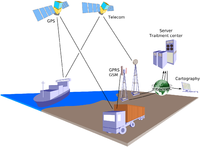
Photo from wikipedia
A living cell senses its environment and responds to external signals. In this paper, we study theoretically the precision at which cells can determine the position of a spatially localized… Click to show full abstract
A living cell senses its environment and responds to external signals. In this paper, we study theoretically the precision at which cells can determine the position of a spatially localized transient extracellular signal. To this end, we focus on the case where the stimulus is converted into the release of a small molecule that acts as a second messenger, for example, Ca^{2+}, and activates kinases that change the activity of enzymes by phosphorylating them. We analyze the spatial distribution of phosphorylation events using stochastic simulations as well as a mean-field approach. Kinases that need to bind to the cell membrane for getting activated provide more accurate estimates than cytosolic kinases. Our results could explain why the rate of Ca^{2+} detachment from the membrane-binding conventional protein kinase Cα is larger than its phosphorylation rate.
Journal Title: Physical review. E
Year Published: 2019
Link to full text (if available)
Share on Social Media: Sign Up to like & get
recommendations!